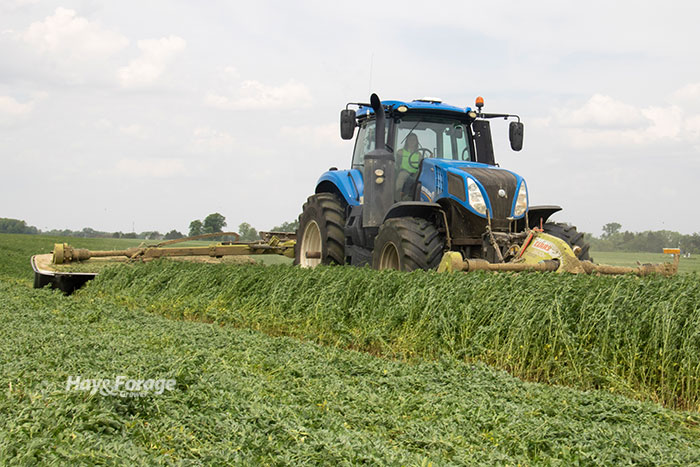
Over the course of the next two months, a large number of hay implements will venture out into fields for their maiden voyage of 2023. Be it grass or alfalfa, first cutting separates itself as a time that often defines the hay or haylage harvest season.
One of the unique advantages of harvesting forage is that desired forage quality can largely be attained by the grower simply manipulating the time of cutting. In the same vein, yield can also be dictated, but at the expense of forage quality.
No other harvest during the year offers more opportunity for obtaining high forage quality — as defined by digestible fiber — than the initial spring cutting. Further, this forage often makes up the greatest proportion of the total-season yield. It is often the only cutting of the year that is not limited by soil moisture availability.
Don’t maximize yield
The enhanced yield potential of first cutting means that whatever forage quality is obtained — good or bad — your barn or silo is going to be full of it, and you’ll live with the spoils or consequences for most of the ensuing year and part of the next one. Maximizing forage yield will likely result in forage of unacceptable quality.
Alfalfa yield, or dry matter accumulation, changes more dramatically in the spring and early summer compared to any other time of the year. Estimates are that alfalfa packs on 100 to 150 pounds of dry matter per acre per day during the late-vegetative to late-bud stages. In five days, dry matter yield jumps 1/4 to over 1/3 ton per acre. The yield–quality tradeoff is never so in play as it is with first cutting.
Perennial grasses also offer tremendous yield potential with their initial spring growth. However, the yield–quality tradeoff is even more dramatic than with alfalfa because fiber digestibility drops so dramatically after grasses transition into reproductive stages. It’s unfortunate that far too many acres of grass hay are harvested after significant seedhead development, resulting in a product that mimics the quality of cordwood.
Often, a late first cutting of alfalfa or grass reduces the yield of the second cutting because soil moisture becomes more limited. Conversely, a timely first cutting often accounts for more rapid regrowth, setting up a productive second cutting.
First cutting is the only one when there is no number of days since the previous harvest. The first-cut harvest decision often dictates the schedule for the rest of the season. When the first cut is made may impact how many future cuttings will be possible, the interval between cuttings, and how late in the fall the final cutting will be harvested, which, in turn, impacts future stand life.
A quality advantage
As with any cutting, forage quality is largely dictated by time of harvest. The initial cutting of the season offers equal opportunity for being the best forage quality of the season or the worst.
No other cutting of alfalfa grows under the environmental conditions characterized by spring. During early plant development, temperatures are mostly cool, which is good news from a forage quality standpoint. As vegetative growth continues and into early reproductive (bud or seedhead) stages, the potential weather scenarios span any number of possible outcomes.
This range of environmental conditions makes it nearly impossible to eyeball forage quality. Calendar dates are useless, as is phenotypic maturity stage to some degree. Relative forage quality (RFQ) can be as much as 100 points different from year-to-year on the same date, and the same phenotypic stage doesn’t always correlate to same forage quality from one year to the next.
To be sure, Mother Nature is calling the shots on forage quality when it comes to first cutting; however, absolute or changes in quality are not apparent by visual inspection. It’s up to the haymaker to adjust.
Hot and wet weather brings much different results than cool and dry. Further, environmental conditions change from day-to-day more in the spring than at any other point in the growing season. Therefore, it’s important to pay attention and monitor forage quality more so than any other cutting of the season.
Alfalfa practitioners and researchers have spent years developing systems to estimate forage quality without physically cutting plants and sending them to a forage laboratory for analysis, although the latter approach works, too.
By now, most growers are familiar with the predictive equations for alfalfa quality (PEAQ), which is based on plant height and maturity stage. Another popular approach is based on tracking growing degree units (GDU). Both methods will be far more effective than looking at plants or the calendar. Choose your weapon but choose a weapon.
First-cut fiber digestibility can be the best of the season. Those typical cool days and nights are generally the hay producer’s friend. Once warm to hot weather sets in, or if wet weather delays the harvest, fiber digestibility can quickly move from the best to the worst of the year. This is true for monoculture alfalfa stands and even truer for mixed or grass stands.
The rate of fiber digestibility decline is unmatched by any other alfalfa cutting. This means that the harvest window is usually smaller, unless extended cool weather prevails. Reduced-lignin alfalfa genetics can raise neutral detergent fiber digestibility (NDFD) by as much as 15%, which will help widen the acceptable harvest window.
To be sure, it’s not always necessary to harvest forage that is “rocket fuel” quality, especially when many dairy diets no longer include large amounts of alfalfa. Shooting for too high of quality will needlessly lower yields in many cases.
As we move closer to first-cut forage harvest time, be reminded that there are no other field activities that are more important or will have a greater positive economic impact than getting forage cut on time. Rarely do farmers complain about their forage being too good, but it’s often we hear grumblings about the opposite situation.

